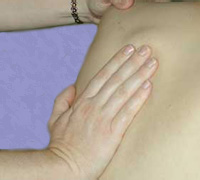 Derived from the Latin words "myo" - meaning muscle, and "fascia" - for band; myofascial release therapy
Derived from the Latin words "myo" - meaning muscle, and "fascia" - for band; myofascial release therapy
releases tension from the fibrous bands of connecting tissue (fascia). Myofascial release therapy aims to free constrictions or blockages in the fascia, thereby alleviating problems with connective tissue scarring or injury.
The doctor uses myofascial release therapy to help individuals with poor posture, physical injury, illness, and emotional stress. Using this therapy, disruptions of the fascial network are freed and tension on bones, muscles, joints, and nerves is relieved. Ultimately, myofascial release restores complete balance back to the body.
Myofascial release therapy utilizes gentle, kneading manipulation that softly stretches, softens, lengthens and realigns fascia. After careful observation of one's posture, the doctor feels for stressed areas of the body. When restricted areas are found, he gently stretches tissues found along the direction of the muscle fibers. This stretch is held for a couple of minutes until a softening or release is felt. These stretches are repeated until the tension is felt no more. A myofascial release session may last up to an hour and can be administered one to three times per week depending on a patient's condition.
In addition, myofascial release therapy can be used to treat back pain; help persons suffering from frozen shoulder, headaches, chronic fatigue syndrome, menstrual problems, incontinence, tennis or golfer's elbow, shin splints, sprains, rheumatoid arthritis, muscle spasms, whiplash injuries, and carpal tunnel syndrome. Furthermore, myofascial release can be administered to children suffering from birth trauma, head injuries, cerebral palsy, and scoliosis as well.